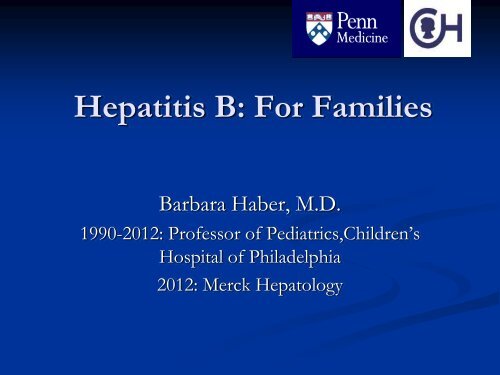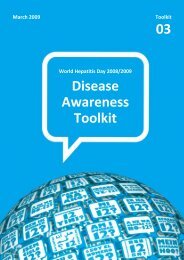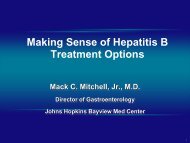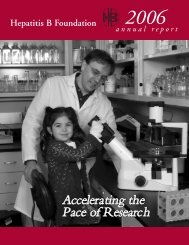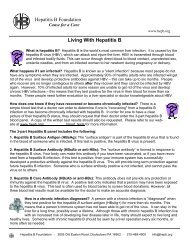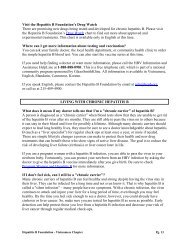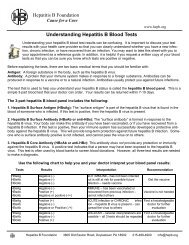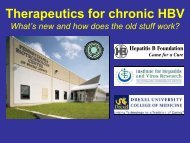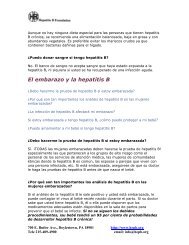Download PowerPoint - Hepatitis B Foundation
Download PowerPoint - Hepatitis B Foundation
Download PowerPoint - Hepatitis B Foundation
Create successful ePaper yourself
Turn your PDF publications into a flip-book with our unique Google optimized e-Paper software.
<strong>Hepatitis</strong> B: For FamiliesBarbara Haber, M.D.1990-2012: Professor of Pediatrics,Children’sHospital of Philadelphia2012: Merck Hepatology
Background
IOM Report: Burden of HBVDisease [1]• 15% to 25% risk of early death caused by livercancer or end-stage liver disease among patientswith chronic HBV infection [2,3]• WHO global HBV estimates [3]• ~ 2 billion people infected with HBV• ~ 350 million people living with chronic HBVinfection, 1.25 million in the U.S.• ~ 600,000 deaths annually caused by HBV-relatedliver disease or HCC1. Institute of Medicine. <strong>Hepatitis</strong> and liver cancer: a national strategy for prevention and control of hepatitis B and C. 2010. 2. Beasley R, et al. In: HollingerFB, Margolis H, Lemon SM, editors. Viral hepatitis and liver disease. Proceedings of the 1990 international symposium on viral hepatitis and liver disease:contemporary issues and future prospects. 1991. 3. WHO. <strong>Hepatitis</strong> B fact sheet.
<strong>Hepatitis</strong> BA significant problem
Global Patterns ofChronic HBV Infection• High (>8%): 40-45% of global population• 10-20% have + surface antigen• Lifetime risk of infection >60%• Early childhood infections common• Intermediate (2%-7%): 35-43% of global population• Lifetime risk of infection 20%-60%• Infections occur in all age groups• Low (
Impact of Immigration on USHBV PrevalenceImmigration Numbers by Continent: 2000-2009 [1]~ 3.6 million Asians~ 875,000South Americans~ 1.3millionEuropeansHBsAg Prevalence [2]≥ 8% (high)2% to 7% (intermediate)< 2% (low)~ 804,000Africans1. US Department of Homeland Security. Yearbook of Immigration Statistics: 2009. 2. Weinbaum CM, et al. MMWRRecomm Rep. 2008;57(RR-8):1-20.
Need to Know How You Get It:Horizontal TransmissionConcentration of Hep B in BodyHighFluidsModerateLowUndetectableblood semen urineserum vaginal fluid feceswound exudates saliva sweattearsbreastmilk
Vertical Transmission• Increased when mother is e Ag positive• 90% chance of infant being infected vs.• 20% risk if mom is e Ag negative• Maternal acute hep B in 3 rd trimester
What makes childrendifferent
Why should we care about childrenwith <strong>Hepatitis</strong> B• Does <strong>Hepatitis</strong> B impact the life of children?• Do children get cirrhosis or cancer?• Do children feel ill?
Why should we care• Does <strong>Hepatitis</strong> B impact the life of children?- YES• Do children get cirrhosis or cancer?– Rarely• Do children feel ill?- Rarely
• Socially difficult disease• Daycare, school, sleep-overs, dating• Do not need to disclose• will be discussed in the break-out sessions• Long-term health consequences• Highly contagious• Constant worry
Differences in Pediatric Hep B• Children are less likely to clear hepatitis B• Only 5% of newborns that acquire theinfection from their mother at birth willclear
100Outcome of <strong>Hepatitis</strong> B Virus Infection byAge at Infection100Chronic Infection (%)80604020Chronic Infection80604020Symptomatic Infection (%)0Symptomatic Infection0Birth 1-6 months 7-12 months 1-4 years Older Childrenand AdultsAge at Infection
<strong>Hepatitis</strong> B Mortality• Other than flu and pneumococcus,HBV claims more lives than anyother vaccine-preventable disease(VPD) (>5,000/year)• 1000 Die annually from cancer• 4000 Die annually from cirrhosis• HBV is 100x more infectious thanHIV
• The life cycle of the <strong>Hepatitis</strong> B virus is a majorcontributor to the unique disease aspects• Initially lives as a plasmid• With time, integrates into the host genome• The result: Likely to live in the host for a lifetime
PreventionVaccination
Vaccination and Prevention
Elimination of HBV Transmission, United StatesStrategy• Prevent perinatal transmission• Routine vaccination of all infants• Vaccination of children in high-risk groups• Vaccination of all children to age 18• Federal mandate in the VFC act 1993• Vaccination of adults in high-risk groups
HBV Incidence by Year: UnitedStatesCases per 100,000 Population14121086420(1966-2005)Vaccine licensedHBsAg screening of pregnantwomen recommendedDecline amongMSM & HCWsInfant immunizationrecommendedOSHA rule enactedAdolescent immunizationrecommendedDecline amongIDUs1967 1971 1975 1979 1983 1987 1991 1995 1999 2003YrWasley A, et al. MMWR Surveill Summ. 2008;57(2):1-24. Wasley A, et al. MMWR Surveill Summ. 2007;56(3):1-24.OSHA. Available at:http://www.osha.gov/pls/oshaweb/owadisp.show_document?p_table=STANDARDS&p_id=10051.
<strong>Hepatitis</strong> B Vaccine School Entry Laws, 2003WASHINGTONOREGONMONTANANORTHDAKOTAMINNESOTAVTMAINEIDAHOWYOMINGSOUTHDAKOTAWISCONSINMICHIGANNEWYORKNHMACTRINEVADAUTAHNEBRASKAIOWAILLINOISINOHIOPENNSYLVANIANJDECOLORADOWVDCMDCALIFORNIAARIZONANEWMEXICOKANSASOKLAHOMAMISSOURIARKANSASKENTUCKYTENNESSEEVIRGINIANO.CAROLINASO.CAROLINAMSALABAMAGEORGIATEXASLAALASKAFLImplementedNo School Entry Laws
• Routine infant<strong>Hepatitis</strong> B VaccinationRecommendations• Ages 11-15 “catch up”, and through age 18 (VFC everyone iseligible)• Over age 18– high risk• Occupational risk (HCW’s)• Hemodialysis patients• Multiple sex partners or prior STD• Inmates in correctional settings• MSM• IVDU• Institutionalized (developmental disability, etc)CDC (Advisory Committee on Immunization Practices)
<strong>Hepatitis</strong> B VaccinationRecommendations• Post-vaccination testing: 1-2 months after last shot, ifestablishing response critical• Infants born to HBsAg-positive mothers• HCW• HIV, Dialysis• Non-responders• Household members living with an infected person• Hep B sAb levels are used to determine effectiveness• The minimum protective level of anti-HBs is 10 IU/ml
<strong>Hepatitis</strong> B VaccinationACIP Recommendations• Pre-vaccination testing is generally not costeffective (Vaccination does not mean screening)• Hep B core Ab is an indicator of a current orprevious HBV infection.• May combine with HBsAb and HBsAg for screeningat-risk populations to determine immune status.
Infants:Treatment• HBIG within 12 hours of birth• Vaccine at birth, 2 nd dose at first well check (1-2months of age), 3 rd dose btwn 6-18 months• HBIG alone only 75% effective, vaccine at birthimproves vaccination rate• Together – 95% effective
Reduced Incidence of HBVInfection Among Children of AllIncidence Among Persons Aged< 19 yrs (per 100,000) [1]7654321Races in the USAsian/Pacific IslanderBlackAmerican Indian/Alaska nativeHispanicWhite01990 1992 1994 1996 1998 2000 2002 2004Yr• Despite dramatic reduction in childhood infection rates, ~ 1000 cases of perinatal HBVinfection are estimated to occur each yr [2]1. Mast EE, et al. MMWR Recomm Rep. 2005;54(RR-16):1-31.2. Ward JW. Am J Public Health. 2008;98:779-781.
Gaps in care for the infantvaccine program• The US Vaccination program has been highlyeffective except,• Mothers are not always screened• Doses of HBIG and Vaccine not prompt• May be transmitted in Utero• High viremia at time of birth• Guidelines for infants are standard, Guidelines forthe mother are not
Post exposure prophylaxis• Adults: Needlesticks, sexual contact• HBIG immediately and no longer than 14 day delay(0.06mL/kg)
Post-exposure HBIG/VaccineGuidelinesUnvaccinatedVaccinated: KnownresponderVaccinated: Knownnon-responderVaccinated:Unknown responsestatusHBIG one dose andinitiate vaccine seriesNo treatmentHBIG 2 doses andconsider revaccinateTest for HepB sAb: ifinadequate HBIG andvaccine series
ScreeningThe question is NOTwere you vaccinated
Children Who Should Be Screened for Chronic HBV Infection• Children born in countries endemic for HBV — even if they receivedhepatitis B vaccine in their country of origin– All of Asia– All of Africa– South- and mid-Pacific Islands– Europe (Eastern and Mediterranean countries), Greenland, and Russia– Middle East– South America: Amazon Basin– Caribbean– Indigenous populations from the Arctic, Australia, and New Zealand• Children born in the US to immigrant parents from endemic areas• Infants born to HBsAg+ mothers• Children living with an HBsAg+ individual– Including children who received hepatitis B vaccine after birth who were not screenedbefore vaccinationHaber, BA, et al. Pediatrics. published online Oct 5, 2009. (doi: 10.1542/peds.2009-0567)Adapted from Weinbaum CM, et al, MMWR Recomm Rep. 2008;57(RR-8):1–20
When do we know someone haschronic HBV?• Chronic Infection = + HBV PCR X 2 or sAgpositive X 2, 6 months apart
Understanding and interpretinglaboratory tests and the healthconsequences
Laboratory TestsUnderstanding your tests• Liver tests, hepatic enzymes• Complete blood count• PT• AFP• <strong>Hepatitis</strong> B• Surface antigen, antibody• E antigen, antibody• Core• DNA level• Genotype (not always done)
What Is a “Normal” ALT Level?Adult Data• 9221 first-time potential blood donors• 74% suitable donors after exclusion of anemia, serologic reactivity onscreening assay, seizure, sexual, and other risk• 57% determined to be at “low risk” for liver disease• BMI < 25• Normal serum cholesterol, triglycerides, and glucose levels• Absence of concurrent medication use• Updated healthy ALT upper limits determined from the group oflow-risk individuals• Males: 30 IU/L• Females: 19 IU/LPrati D, et al. Ann Intern Med. 2002;137:1-10.
Phases of Chronic <strong>Hepatitis</strong> B InfectionPhase Labs and Histology NoteImmuneTolerantImmuneActiveInactiveHBsAgCarrierReactivationDNA>20,000 IU/mlALT normalHBsAg and HBeAg detectableMinimal liver inflammation and fibrosisDNA levels declineALT elevatedHBsAg and HBeAg remain detectableLiver inflammation and fibrosis can developDNA
MonitorandCounsel
Follow-up of patients with<strong>Hepatitis</strong> B• Office visits 1-2 times yearly• Annual alpha-fetoprotein (AFP)• Abdominal ultrasound, baseline and at more frequent intervalsdepending on age and AFP level• HBV S Ag, S Ab, e Ag, e Ab• DNA levels baseline, when treatment is being considered andafter sero-conversion
Non-Invasive Monitoring• Ultrasound• Blood tests – Fibroscan, FibroTest, FibroSure,Actitest (used more commonly in hepatitis C)• Elastography
Role of Liver Biopsy in EvaluatingPatients With Chronic HBVInfection• Purpose of the biopsy• Establish baseline severity of liver disease• Exclude other coexistent causes of liver disease (eg,fatty liver or alcoholic liver disease)• Greatest utility in patients who do not meet clearlydefined recommendations for treatment/no treatment [1]• Liver biopsy decisions should consider age, HBeAgstatus, HBV DNA levels, clinical factors that suggestchronic liver disease or portal hypertension, newsuggested definitions of normal ALT levels [1,2]1. Lok AS, et al. Hepatology. 2009;50:661-662. 2. Prati D, et al. Ann Intern Med. 2002;137:1-10.
Recommended approach tomonitoring children withchronic hepatitis B infectionaALT and WBC/Plt are generally partof a hepatic function panel and CBCb Greater than the testing laboratoryULN, or >40 IU/L, whichever is lowerc ALT and AFP q6-12 mos; HBeAg/Anti-HBe and HBV DNA q12 mos; Alsoconsider ultrasound q1-2 yr,particularly with elevated ALT or AFP,or family history of HCC<strong>Hepatitis</strong> B <strong>Foundation</strong>Haber, BA, et al. Pediatrics. published online Oct 5, 2009. (doi: 10.1542/peds.2009-0567)www.hepb.org
AASLD GuidelineRecommendations forCounselingRecommendations Regarding Prevention of Transmission of HBV to OthersPersons who are HBsAg positive should:• Have sexual contacts vaccinated• Use barrier protection during sexual intercourse if partner not vaccinated or naturally immune• Not share toothbrushes or razors• Cover open cuts and scratches• Clean blood spills with detergent or bleach• Not donate blood, organs, or spermChildren and adults who are HBsAg positive:• Can participate in all activities including contact sports• Should not be excluded from daycare or school participation and should not be isolated from otherchildren• Can share food, utensils, or kiss othersLok AS, McMahon BJ. Hepatology. 2009;50:661-662. Chronic <strong>Hepatitis</strong> B: Update 2009, Lok ASF, McMahon BJ,www.aasld.org. Copyright@2009. American Association for the Study of Liver Diseases, Reproduced with permission ofthe American Association for the Study of Liver Diseases.
AASLD GuidelineRecommendations forCounseling“6. Abstinence or only limited use of alcohol is recommended in hepatitisB carriers (Grade III)7. Persons who are positive only for anti‐HBc and who are from a lowendemic area with no risk factors for HBV should be given the fullseries of hepatitis B vaccine (Grade II‐2)”Lok AS, et al. Hepatology. 2009;50:661-662.
Adverse Liver Outcomes(Cirrhosis and HCC) in ChronicHBV Infection• Long-term follow-up (median: 29 mos) of 3233 patients from Hong Kong withchronic HBV infection• Cirrhosis-assoc complications: ascites, SBP, variceal bleeding, PSE, HCCRisk of Complications (%)40 ALT > 1 to 2 x ULN*ALT > 2 to 6 x ULN*30ALT 0.5-1.0 x ULN*ALT > 6 x ULN †ALT < 0.5 x ULN20100*P < .0001 vs ALT < 0.5 x ULN.†P < .05 vs ALT < 0.5 x ULN.0 30 60 90 120 150 180Follow-up (Mos)Reproduced from Yuen MF, et al. Gut. 2005;54:1610-1614 © 2005 with permission from BMJ Publishing Group Ltd.
The REVEAL Study: Serum HBVDNA Level and Risk of HCC• Long-term (mean follow-up: 11.4 yrs) cohort study to determine risk of cirrhosis andHCC among untreated HBsAg+ individuals in TaiwanMultivariable‐Adjusted HR121086420< 300Chen CJ, et al. JAMA. 2006;295:65-73.All participants (N = 3653)HBeAg negative (n = 3088)1 1 1.1 12.3 2.66.6300-9999 10,000-99,999100,000-999,999HBV DNA (copies/mL)6.1 6.110.6≥ 1 million
Risk of HCC and CirrhosisAccording to Baseline HBV DNAHCC (% per Yr) [1]1.41.21.00.80.60.4HBV DNA (copies/mL)< 300300-999910,000-99,999100,000-999,999≥ 1 millionCirrhosis (% per Yr) [2]3.02.52.01.51.0HBV DNA (copies/mL)< 300300-999910,000-99,999100,000-999,999≥ 1 million0.20.5001. Chen CJ, et al. JAMA. 2006;295:65-73. 2. Iloeje UH, et al. Gastroenterology. 2006;130:678-686.
Questions?


